Last Updated on 2 years by admin
Are you concerned about your betta fish’s health? Fungal infections are a common problem that can cause significant harm to your aquatic companion. However, with proper treatment and care, you can help your betta fish recover and thrive once again.
This comprehensive guide will provide you with valuable insights on the various treatment options, remedies, and preventive measures to manage fungal infections in betta fish effectively. From identifying the symptoms to creating a clean and healthy environment, we will guide you through the essential steps to ensure the well-being of your beloved aquatic pet.
Key Takeaways
- There are various treatment options, remedies, and preventive measures available to manage fungal infections in betta fish.
- A clean and healthy environment can help prevent fungal infections from developing.
- Natural remedies and antifungal medications can be used to treat fungal infections in betta fish effectively.
- Isolating infected betta fish is crucial to prevent the spread of infection.
- Observation, proper nutrition, and maintenance are essential for proper post-treatment care.
Understanding Fungal Infections in Betta Fish
If you’re a betta fish owner, it’s essential to understand the risks associated with fungal infections. Despite their resilience, betta fish are not immune to these infections, which can compromise their health and well-being. In this section, we will explore the causes, symptoms, and risk factors associated with fungal infections in betta fish.
What Causes Fungal Infections in Betta Fish?
Fungal infections in betta fish can arise due to several reasons, including poor water quality, stress, and injuries. Fungi that commonly affect betta fish include Saprolegnia and Achlya species, which thrive in warm, moist environments. In aquaria, these fungi can grow rapidly, particularly in stagnant water conditions or when fish are stressed, injured, or weakened due to prolonged illnesses.
What Are the Symptoms of Fungal Infections in Betta Fish?
Identifying fungal infections in betta fish can be challenging, as the symptoms can overlap with those of other diseases. Some common signs to look out for include:
- White, grayish, or cotton-like growth on the fish’s skin, fins, or gills
- The fish’s skin or fins appear frayed, tattered or have holes
- Loss of appetite and lethargy
- Erratic swimming patterns or difficulty swimming
- Reddened or inflamed areas near the infected site
What Are the Risk Factors for Fungal Infections in Betta Fish?
Several risk factors can increase the likelihood of fungal infections in betta fish. These include:
- Inadequate tank hygiene and water maintenance
- Overcrowding or poor tank size
- Presence of other diseased fish in the same tank
- High-stress levels, such as sudden changes in temperature or water conditions
- Frequent netting or handling of the fish, leading to injuries and stress
Preventing and Managing Fungal Infections in Betta Fish
Preventing and managing fungal infections in betta fish involves maintaining a clean and healthy environment, reducing stress, and promptly addressing any injuries or illnesses. In the next section, we will explore ways to create an optimal tank environment that reduces the risk of fungal infections.

Creating a Clean and Healthy Environment
To prevent fungal infections in betta fish, it is crucial to maintain a clean and healthy environment. Here are some tips to create an optimal living space for your pet:
- Tank Size: Betta fish require a minimum of a 5-gallon tank to thrive.
- Water Condition: Betta fish prefer warm water, with a temperature range of 76-82°F. Use a water thermometer to monitor the temperature and a water conditioner to remove chlorine and chloramine from tap water.
- Water Changes: Regular water changes are essential to remove excess waste and maintain proper water chemistry. Aim for 25-50% water changes once a week.
- Proper Filtration: A filter is necessary to remove debris and bacteria from the water. Choose a filter that is appropriate for the tank size and follow the manufacturer’s instructions for maintenance.
- Tank Décor: Decorate the tank with live or silk plants, hiding places, and soft substrate to create a natural and comfortable environment for your betta fish.
By following these tips, you can prevent fungal infections in betta fish by keeping their living space clean and healthy.
Fungal Infections and Poor Water Conditions
Poor water conditions can increase the risk of fungal infections in betta fish. High levels of ammonia and nitrites can stress the fish’s immune system and make them more susceptible to fungal infections. Additionally, overcrowding, overfeeding, and overuse of medications can also contribute to poor water conditions.
Therefore, it is essential to monitor the water parameters regularly using a test kit and adjust accordingly. Ensure that the filter is working correctly and the tank is not overcrowded. Feed your betta fish only what they can consume in 2-3 minutes and avoid overusing medications.
Quarantine Tank
If you introduce new fish or plants to the tank, isolate them in a quarantine tank for two weeks before introducing them to the main tank. This preventive measure can help you identify any potential health issues and prevent the spread of fungal infections to other fish in the main tank.
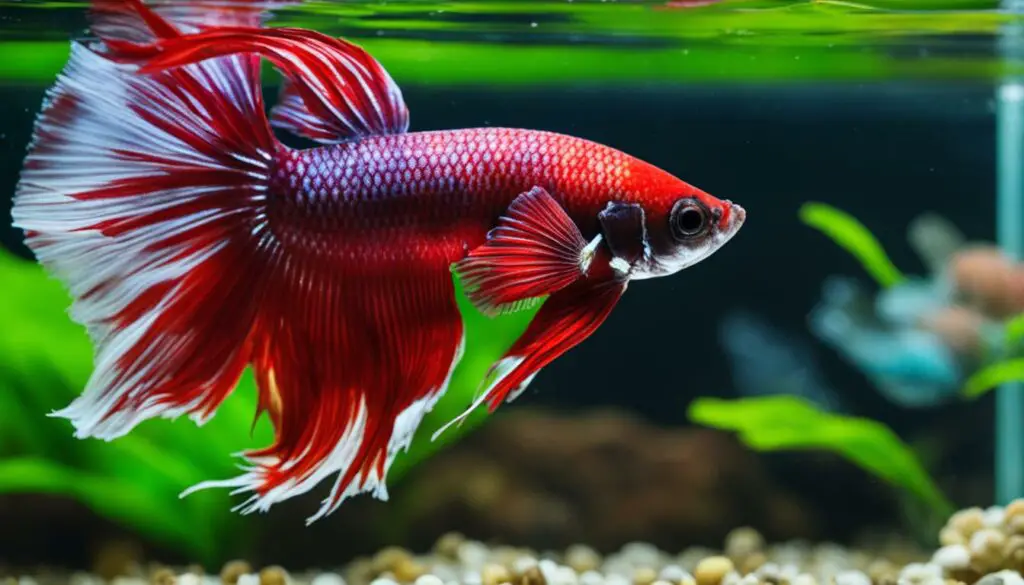
Keeping a clean and healthy environment is crucial to prevent fungal infections in betta fish. In the next section, we will explore natural remedies for betta fish fungal infection treatment.
Natural Remedies for Betta Fish Fungal Infection
If you prefer natural remedies over medications, there are several options available to treat fungal infections in betta fish. Here are some of the most effective remedies:
- Salt Baths: One of the most popular remedies is a salt bath. Dissolve aquarium salt in a separate container of water, and immerse your betta fish in the solution for 10-15 minutes daily for up to 10 days. The salt bath helps to remove excess slime coat and promotes the growth of new tissue.
- Tea Tree Oil: Tea tree oil has antifungal properties and can be used to treat betta fish fungal infections. Add a few drops of tea tree oil to your betta fish’s tank, ensuring the dosage is appropriate for the size of the tank and the severity of the infection.
- Indian Almond Leaves: Indian almond leaves contain tannins that have antifungal and antibacterial properties. Add a few leaves to your betta fish’s tank, and replace them every few days as they decompose.
- Garlic: Garlic has natural antifungal properties and can be added to your betta fish’s food or water. You can also make a garlic paste and apply it directly to the infected area of your betta fish.
It’s important to note that while natural remedies can be effective, they may not be as potent as medications. It’s crucial to monitor your betta fish’s condition closely and seek the appropriate medical treatment if necessary.

Antifungal Medications for Betta Fish
When it comes to treating fungal infections in betta fish, antifungal medications can be a highly effective option. These medications are specially formulated to target and eliminate fungal infections, providing rapid relief for your betta fish.
But what is the best treatment for fungal infection in betta fish? There are various antifungal medications available in the market, but it’s crucial to choose the most suitable one for your betta’s specific infection. Some of the most commonly recommended antifungal medications for betta fish include:
| Antifungal Medication | Usage Instructions | Precautions |
|---|---|---|
| Ketoconazole | Administered via the betta fish’s food. | Avoid using with other medications and closely monitor betta fish’s reaction. |
| Malachite Green | Added to the betta fish’s water for a specified period. | Avoid using with other medications and carefully follow dosage instructions. |
| Methylene Blue | Added to the betta fish’s water for a specified period. | Closely monitor betta fish’s reaction and avoid overdosing. |
Before administering antifungal medications, it’s important to read and follow the instructions provided with the medication. Additionally, it’s recommended to consult with a veterinarian or a fish expert to ensure appropriate usage and potential side effects.
If you notice any adverse reactions or no improvement after using antifungal medications, seek immediate medical attention for your betta fish.

Treating Fungal Infections in Betta Fish: Step-by-Step Guide
If you suspect your betta fish has a fungal infection, it is crucial to take action immediately. The longer you wait, the more severe the infection can become, potentially leading to fatality. In this section, we will provide a step-by-step guide on how to treat fungal infections in betta fish.
Step 1: Identify the Infection
The first step in treating a fungal infection in betta fish is to identify whether your fish is indeed infected. Common signs of fungal infections include white fuzzy growth on the fins, body, or gills, frayed fins, lethargy, sluggishness, and loss of appetite.
If you notice any of these symptoms, it’s essential to isolate the infected fish immediately to prevent the spread of the infection to other tank inhabitants.
Step 2: Create a Treatment Plan
Once you have confirmed that your betta fish has a fungal infection, you need to create a treatment plan. You can choose to treat the infection with natural remedies or antifungal medications.
Natural remedies such as salt baths, tea tree oil, and Indian almond leaf can be effective in treating mild fungal infections. However, for severe infections, antifungal medications such as Ketoconazole, Methylene Blue, and Fungus Eliminator may be necessary.
Step 3: Implement the Treatment
Regardless of the treatment method you choose, it’s crucial to follow the instructions carefully. Overdosing can harm your fish, and underdosing may not be effective.
If using natural remedies, prepare the appropriate solution and add it to the tank. Ensure your fish is in optimal health before administering any medication. For antifungal medications, follow the dosage guidelines and remove any carbon filters before use.
Step 4: Monitor and Adjust Treatment
After implementing the treatment, it’s essential to monitor your fish’s progress carefully. Observe any changes in behavior, appetite, and physical appearance. If there are any adverse reactions, immediately discontinue the treatment and seek professional veterinary advice.
If there are no noticeable improvements after a few days, adjust the dosage or treatment method accordingly. Be patient and consistent with treatment until the infection has completely cleared.
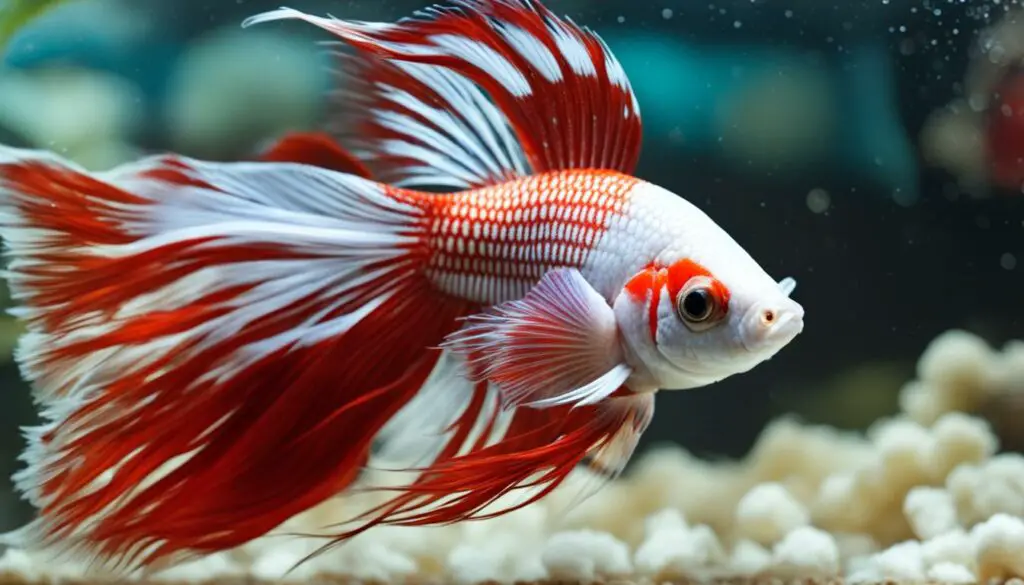
Following these steps can help you effectively treat fungal infections in betta fish. Remember to maintain a clean and healthy environment to prevent future infections, and seek professional veterinary advice if necessary.
Isolating Infected Betta Fish
Isolating infected betta fish is essential to prevent the spread of fungal infections. It also ensures that other tank inhabitants are not affected.
The first step is to identify the infected fish. Look out for signs of sluggishness, lethargy, frayed fins, or discoloration. Once identified, separate the infected betta fish immediately and move them to a quarantine tank. This tank should have the same water conditions and temperature as the main tank.
When setting up the quarantine tank, ensure that it is adequately aerated and filtered. Placing new plants or decorations is not recommended, as they may harbor harmful bacteria and fungi. Additionally, make sure that the tank is not overcrowded, and there is ample space for the fish to swim comfortably.
During the isolation period, it’s recommended to monitor the infected betta fish closely. Observe their behavior, eating patterns, and physical appearance. If the symptoms exacerbate or new signs of illness appear, it’s best to seek professional help.
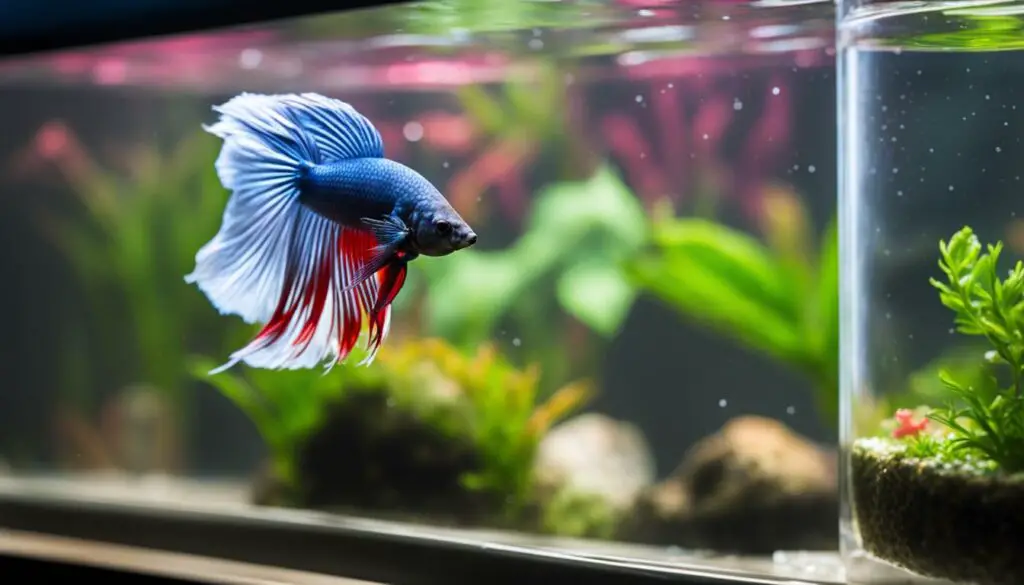
“Proper isolation and regular monitoring are crucial in managing fungal infections in betta fish.”
Tips on Reintroducing the Infected Fish to the Main Tank
Before reintroducing the infected betta fish to the main tank, ensure that they have fully recovered and are no longer exhibiting any signs of illness. This process typically takes a few weeks, depending on the severity of the fungal infection.
When reintroducing, slowly acclimate the fish to the main tank’s water conditions. Start by adding a small amount of water from the main tank to the isolation tank and gradually increasing it over time. This process helps the fish adjust to the new environment without experiencing stress.
It’s also recommended to treat the main tank with antifungal medication a few days before reintroducing the fish. This measure will ensure that there are no remaining traces of fungi in the tank, reducing the risk of re-infection.
Finally, monitor the reintroduced fish closely, and observe any changes in behavior or physical appearance. If any signs of infection resurface, repeat the isolation and treatment process.
Tips for Betta Fish Recovery and Post-Treatment Care
After completing the treatment, your betta fish needs proper care and observation to ensure a full recovery. Here are some tips to follow:
- Monitor your betta fish’s behavior and appetite. If you notice any changes, consult with a veterinarian.
- Continue regular water changes to maintain a clean and healthy environment for your fish.
- Feed your betta fish a balanced diet with high-quality food that provides essential nutrients and vitamins to support their immune system.
- Add aquarium salt to the water to improve gill function and overall health.
- Avoid overcrowding the tank as it increases stress levels and susceptibility to infections.
By following these tips, you can promote a speedy and healthy recovery for your betta fish. Remember, good post-treatment care can prevent the resurgence of fungal infections.
Note: If you notice any recurring symptoms or prolonged health issues, consult with a veterinarian for specialized treatment.
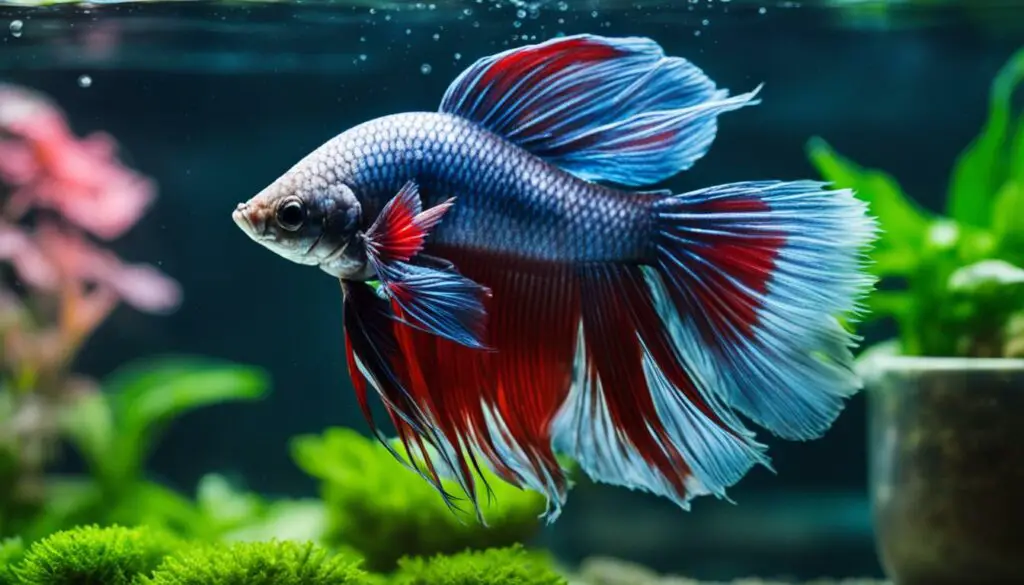
Preventing Future Fungal Infections in Betta Fish
Prevention is the best defense against fungal infections in betta fish. By implementing the following measures, you can minimize the risk of fungal infections and maintain a healthy, stress-free environment for your aquatic companion:
- Proper tank setup: Ensure the tank is appropriately sized, with adequate filtration, and a suitable temperature range (76-82°F). The water chemistry should also be within the recommended parameters (pH 6.0-7.5).
- Regular water changes: Perform partial water changes of 25% every week to remove any buildup of waste and toxins in the tank.
- Quarantine new fish: Quarantine new fish for at least 2 weeks before introducing them to the main tank to ensure they aren’t carrying any infections or diseases.
- Healthy diet: Provide a balanced and nutritious diet to boost your betta fish’s immune system. Consider including foods that contain antioxidants, vitamins, and minerals, such as freeze-dried or live foods.
- Minimize stress: Stress can weaken your betta fish’s immune system, making them more susceptible to infections. Avoid sudden changes in water temperature or aggressive tank mates. Provide adequate hiding spots and plants for your fish to feel secure.
By following these preventive measures, you can help your betta fish lead a healthy and fulfilling life. However, if you notice any signs of fungal infections, don’t hesitate to take prompt action to address the issue.
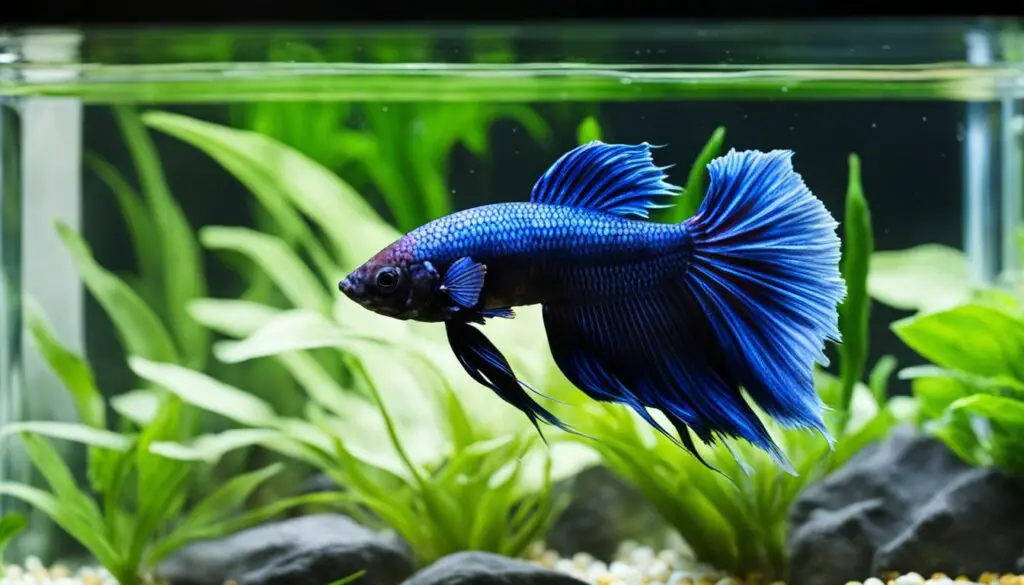
“A clean and healthy tank is the first step in preventing fungal infections in betta fish.”
Common Misconceptions and FAQs About Betta Fish Fungal Infections
As with any health concern, there are plenty of misconceptions and misunderstandings surrounding betta fish fungal infections. Here are a few of the most common questions and misconceptions:
Can betta fish die from a fungal infection?
Yes, a severe fungal infection can be fatal for betta fish if left untreated. However, with prompt and proper treatment, most betta fish can make a full recovery.
Can fungal infections be caused by poor tank conditions?
Yes, poor tank conditions can increase the risk of fungal infections in betta fish. Maintaining a clean and healthy environment, as outlined in Section 3, can help prevent fungal infections.
Can betta fish recover without medication?
In some cases, mild fungal infections may clear up on their own with proper care and a clean environment. However, if the infection is severe, antifungal medication may be necessary to ensure the fish’s recovery.
Can betta fish get fungal infections from other fish?
It is possible for betta fish to contract fungal infections from other fish, especially if the infected fish is introduced to a tank with healthy fish. Isolating infected fish and proper quarantine measures can minimize the risk of transmission.
Can I treat betta fish fungal infections with household remedies?
While some natural remedies may be effective for treating betta fish fungal infections, it is not recommended to rely solely on household remedies without consulting a veterinarian or fish expert. In some cases, home remedies may not be effective and could worsen the infection.
How long does it take for a betta fish to recover from a fungal infection?
The recovery time for betta fish with fungal infections can vary depending on the severity of the infection and the effectiveness of the treatment. It’s important to continue monitoring the fish and providing proper post-treatment care to ensure a full recovery.
Can I return a betta fish to the main tank after recovering from a fungal infection?
Before returning an infected betta fish to the main tank, it’s important to ensure that the fish has made a full recovery and is no longer contagious. Quarantine measures and proper monitoring can help prevent the spread of fungal infections to other fish in the tank.

Conclusion
Now that you have learned how to treat fungal infections in your betta fish, you can take proactive measures to ensure their health and well-being. By creating a clean and healthy environment, utilizing natural remedies or antifungal medications, and monitoring your betta fish’s recovery and post-treatment care, you can prevent future infections and enjoy their companionship for years to come.
Remember These Tips
It’s important to keep in mind that fungal infections are preventable. Maintaining optimal water conditions, proper tank hygiene, and a stress-free environment can go a long way in preventing these infections. Be sure to observe your betta fish carefully, and seek prompt veterinary attention if you notice any signs of illness or infection.
By following the steps outlined in this guide, you can effectively treat fungal infections in betta fish and ensure that they remain healthy and happy. Remember to always consult with a veterinarian or aquatic specialist for personalized care and advice.
Thank you for taking the time to learn how to treat fungal infections in betta fish. We hope that this guide has been helpful in providing valuable insights and tips for caring for your aquatic companion.
FAQ
How do I prevent fungal infections in my betta fish?
To prevent fungal infections in betta fish, maintain a clean and healthy environment by regularly cleaning the tank, ensuring proper water conditions, and performing regular water changes.
What are the symptoms of a fungal infection in betta fish?
Symptoms of a fungal infection in betta fish may include white or gray patches on the body or fins, frayed fins, lethargy, loss of appetite, and behavioral changes.
Can I use natural remedies to treat betta fish fungal infections?
Yes, natural remedies can be used to treat betta fish fungal infections. Options such as salt baths and herbal treatments can be effective in combating fungal infections.
What are some common antifungal medications for betta fish?
Common antifungal medications for betta fish include products containing active ingredients like methylene blue, malachite green, and ketoconazole. Always follow the usage instructions provided.
How do I isolate an infected betta fish?
To isolate an infected betta fish, transfer it to a separate tank or container. This will prevent the spread of the fungal infection to other fish in the main tank.
What should I do after completing the treatment for a betta fish fungal infection?
After completing the treatment, continue to monitor your betta fish’s health and provide proper post-treatment care. This includes maintaining optimal water conditions, providing a balanced diet, and observing any signs of recurrence.
How can I prevent future fungal infections in my betta fish?
Prevent future fungal infections by reducing stress, maintaining a clean tank environment, and promoting overall betta fish health through proper nutrition and tank setup.
Are there any common misconceptions about betta fish fungal infections?
Yes, some common misconceptions include believing that betta fish can “heal themselves” or that fungal infections are solely caused by poor water quality. It’s important to understand the proper treatment and prevention methods.
What is the importance of quarantine when dealing with betta fish fungal infections?
Quarantine is important to isolate and monitor infected betta fish. It helps prevent the spread of fungal infections to other fish in the main tank and ensures the infected fish receives appropriate treatment and care.

